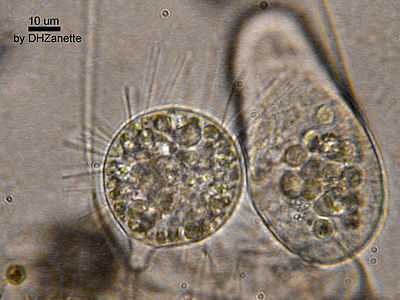Suctoria
| Suctoria | |
|---|---|
 | |
| Scientific classification | |
| Domain: | Eukaryota |
| Kingdom: | Chromalveolata |
| Superphylum: | Alveolata |
| Phylum: | Ciliophora |
| Class: | Phyllopharyngea |
| Subclass: | Suctoria Claparède & Lachmann 1858 |
| Typical orders | |
|
Exogenida | |
Suctoria are ciliates which become sessile in their developed stage and then lose their redundant cilia. They feed by extracellular digestion.[1] They were originally thought to feed by suction – hence their name.[2] In fact, they use specialized microtubules to ensnare and manipulate their prey.[2] They are found in both freshwater and marine environments, including some which live on the surface of aquatic animals, and typically feed on other ciliates. Instead of a single cytostome, each cell feeds by means of several specialized tentacles. These are supported by microtubules and phyllae, and have toxic extrusomes called haptocysts at the tip which attach to prey. Its cytoplasm is then sucked directly into a food vacuole inside the cell, where its contents are digested and absorbed. Most suctoria are around 15-30 μm in size, with a non-contractile stalk and often a lorica or shell.

Suctoria reproduce primarily by budding, producing swarmers which lack both tentacles and stalks but have cilia. They may also reproduce through conjugation, which is peculiar in involving cells of different size and often involves total fusion. The way in which buds are formed is the primary way the different orders of suctoria are distinguished. Among the Exogenida, including common genera like Podophrya and Sphaerophrya, they appear directly on the cell surface. Among the Endogenida, for instance Tokophrya and Acineta, they are formed in an internal pouch and escape through an opening, and among the Evaginogenida, they are formed in a pouch that inverts before they are released.
Once the swarmers have found a place to attach themselves, they quickly develop stalks and tentacles. The cilia are lost, but the underlying infraciliature persists throughout the entire life-cycle. This has a structure which, together with other ultrastructural similarities, places the suctoria within the class Phyllopharyngea.
External links
For videos and pictures of suctorians feeding, moving and reproducing, plus quite a lot of info see http://www.microscopy-uk.org.uk/mag/artmar03/jmcsuctoria.html